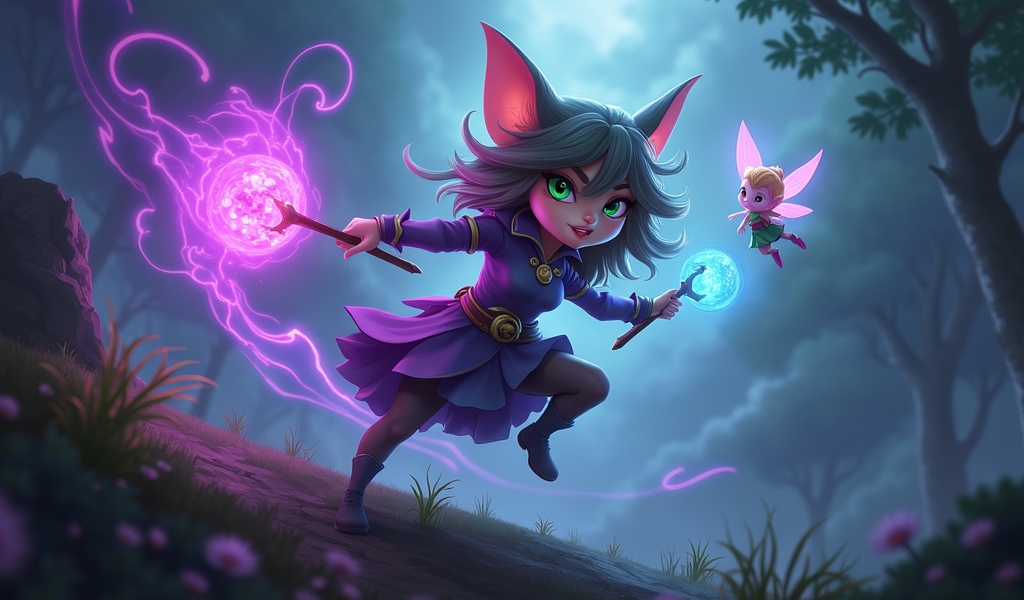Overview
Learning how to play Lulu effectively requires mastering her versatile kit of abilities that can both protect allies and disable enemies through proper positioning, timely polymorphs, and strategic ultimate usage. Her adaptability allows her to thrive in various team compositions by adjusting build paths to meet team needs, while maintaining strong vision control that compensates for her limited mobility.
Table of Contents
Introduction to Lulu: The Yordle Support Queen
Learning how to play Lulu effectively can transform your impact as a support main in League of Legends. This versatile yordle enchanter brings an impressive mix of utility, protection, and surprising damage that makes her a formidable force on the Rift. Whether you’re new to the support role or looking to expand your champion pool, mastering Lulu can significantly elevate your gameplay and help you climb the ranked ladder.
In this comprehensive guide, we’ll explore the essential strategies for how to play Lulu at her full potential. Her unique ability to both save allies and disable enemies makes her one of the most flexible support champions in the game. Furthermore, Lulu’s relatively straightforward mechanics combined with her high skill ceiling means she’s appropriate for players of all skill levels.
The key to success with Lulu lies in understanding her diverse toolkit and making split-second decisions about when to protect and when to attack. With proper positioning, ability usage, and itemization, Lulu can dominate the bot lane and transition into a teamfight powerhouse. Let’s dive into what makes this whimsical support so effective and how you can harness her magical abilities to climb the ranks.
Understanding Lulu’s Kit and Abilities
Before mastering how to play Lulu effectively, you need to thoroughly understand her ability kit. Each of her spells offers dual functionality, making her one of the most versatile supports in League of Legends. This flexibility allows her to adapt to various game situations with ease.
Lulu’s passive, “Pix, Faerie Companion,” adds bonus magic damage to your auto attacks. This makes her trading potential in lane surprisingly strong, especially when combined with her other abilities. Don’t underestimate this additional damage output during early laning phase.
Her Q ability, “Glitterlance,” fires a skillshot that damages and slows enemies it hits. When used with proper positioning, this becomes your primary poke tool and can help secure kills during ganks. According to official League statistics, a well-placed Glitterlance can turn the tide of early skirmishes.
Lulu’s W, “Whimsy,” is perhaps her most unique spell with dual functionality:
- Cast on enemies: Polymorphs them, preventing attacks and spells
- Cast on allies: Grants movement speed and attack speed
Her E ability, “Help, Pix!” also has two distinct uses:
- Cast on enemies: Deals magic damage and reveals them
- Cast on allies: Shields them from damage
Finally, Lulu’s ultimate, “Wild Growth,” enlarges an ally, knocking up nearby enemies and granting bonus health. This powerful ability can save teammates in critical moments or empower your carry to dominate teamfights.

Tip #1: Master Your Laning Phase with Proper Poke and Positioning
When learning how to play Lulu effectively, mastering the laning phase is crucial. Your early game performance often determines how impactful you’ll be throughout the match. The key is finding the right balance between aggression and protection.
Position yourself to maximize your poke potential with Glitterlance (Q) while staying safe from enemy engage attempts. Remember that your auto attacks with Pix deal significant damage, especially against squishy supports or ADCs. Try to weave in auto attacks between your abilities to maximize damage output during trades.
A powerful laning combination involves using your E on an enemy (for damage and vision) followed immediately by Q for an almost guaranteed hit. According to statistical analysis from U.GG, this combo creates significant lane pressure and can force enemies to play defensively or risk being poked out.
However, against aggressive engage supports like Leona or Nautilus, adapt your playstyle to be more defensive. Save your W to polymorph diving enemies and your E to shield your ADC from burst damage. Your positioning should change based on the matchup – stand more forward against enchanters you can outpoke, and more defensively against all-in threats.
Remember these key laning phase priorities:
- Use your E shield proactively when your ADC steps up to last hit
- Save mana for critical moments rather than spamming abilities
- Time your harass with enemy last-hitting attempts
- Track enemy cooldowns to know when you can play more aggressively
Additionally, coordinate with your jungler for ganks. Your W and R provide excellent setup and follow-up for ganks, often resulting in kills or summoner spells being burned. This pressure can snowball your lane into a significant advantage.
Tip #2: Perfect Your Polymorphs for Game-Changing CC
Lulu’s W ability, Whimsy, is arguably one of the most powerful tools in her kit when learning how to play Lulu effectively. This targeted polymorph can completely neutralize enemy threats at crucial moments, acting as a point-and-click crowd control that can shut down assassins, divers, and carries alike.
The key to mastering polymorph lies in target selection and timing. Rather than using it at the first sign of danger, analyze which enemy poses the greatest threat in a given situation. Is it the fed Zed trying to assassinate your ADC? The Yasuo about to land his ultimate? Or perhaps the enemy ADC in prime position to deal damage?
For maximum impact, save your polymorph for these scenarios:
- Interrupting channeled abilities (like Katarina’s ultimate)
- Neutralizing assassins during their dive attempts
- Stopping enemy engage champions mid-combo
- Protecting your carry during high-stakes teamfights
- Preventing enemies from escaping with mobility abilities
Remember that polymorph has a relatively long cooldown (approximately 16-12 seconds depending on rank and cooldown reduction). Using it prematurely can leave you vulnerable during critical moments. Practice patience and discipline with this ability.
In certain situations, using Whimsy on allies instead can be the right call. The movement and attack speed boost can help your ADC kite enemies, secure objectives faster, or chase down fleeing targets. According to data from LoLalytics, high-ranked Lulu players alternate between offensive and defensive W usage based on game state and team compositions.
Finally, consider taking Cosmic Insight in your rune page to reduce the cooldown of this game-changing ability. The lower the cooldown, the more opportunities you have to make impactful plays throughout skirmishes and teamfights.
Tip #3: Time Your Ultimate for Maximum Value
Knowing when to use Wild Growth, Lulu’s ultimate, separates good Lulu players from great ones. This powerful ability not only increases an ally’s maximum health but also knocks up surrounding enemies, making it both a defensive and offensive tool. Mastering its timing is crucial when learning how to play Lulu effectively.
The instinctive use of Wild Growth is to save allies at low health, and while this can be correct, it’s not always the optimal choice. Instead, try to anticipate incoming damage bursts rather than reacting to them. By ulting slightly before major damage arrives, you maximize the effective health granted and potentially turn fights around.
Consider these scenarios for optimal Wild Growth usage:
- When your ally is about to receive heavy burst damage (before they’re low)
- As your engage champion dives into the enemy team for the knock-up effect
- To disrupt enemy channel abilities with the knock-up
- When your hypercarry needs to survive focus fire during crucial teamfights
- To save an ally from certain death (last resort option)
Your ultimate target selection is equally important. While saving your ADC is often correct, sometimes ulting your bruiser or tank who’s in the middle of the enemy team provides more value through the AoE knock-up. Additionally, using it on a mobile assassin like Zed or Talon can surprise enemies who think they’ve secured a kill.
Remember that Wild Growth has good synergy with champions that benefit from being in the center of fights or those who scale with health. Champions like Hecarim, Olaf, Irelia, or even tanks like Malphite can become terrifying threats when empowered by your ultimate.
Finally, communicate with your team about your ultimate status. Let them know when it’s available so they can make aggressive plays knowing they have your backup. This coordination can lead to game-changing moments that catch enemies off guard.
Tip #4: Adapt Your Build Path to Team Needs
One of Lulu’s greatest strengths is her flexible build path, which allows her to adapt to various team compositions and game situations. Understanding how to build Lulu appropriately for each match is crucial for maximizing your effectiveness as a support.
Your mythic item choice should reflect both your team’s needs and the enemy threats. Moonstone Renewer provides consistent healing and is excellent for extended teamfights, while Shurelya’s Battlesong offers engage and disengage potential. Against heavy burst damage, Locket of the Iron Solari can be the difference between your carry surviving or falling.
Consider these situational item choices when deciding how to play Lulu for specific matchups:
- Ardent Censer: When your team has multiple auto-attack reliant champions
- Staff of Flowing Water: For teams with ability-focused carries or mages
- Mikael’s Blessing: Against heavy CC compositions
- Redemption: For additional AoE healing and teamfight utility
- Chemtech Putrifier: When facing heavy healing or lifesteal
Your boot choice matters too. Ionian Boots of Lucidity help with ability haste for more polymorphs and shields, while Mobility Boots enable better roaming and vision control. Against heavy AD or AP threats, consider Plated Steelcaps or Mercury’s Treads respectively.

Tip #5: Vision Control and Map Awareness
While specific to Lulu, vision control and map awareness are fundamental aspects of support play that dramatically impact how to play Lulu effectively. As an enchanter support with limited mobility, proper vision can save you from ganks and help your team secure objectives.
Lulu thrives when she can safely position herself to shield and buff allies or disrupt enemies. This positioning relies heavily on having good vision control. Make regular use of your warding trinket and control wards, especially when approaching objectives or when your team is pushing forward.
Prioritize these key warding locations based on game state:
- Early game: River and tribush to prevent ganks
- Mid game: Enemy jungle entrances and objective approaches
- Late game: Baron and Elder Dragon areas, plus deep wards for pick potential
Your E ability, Help, Pix!, provides vision when cast on enemies. Use this tactically to check unwarded bushes or track enemies who might otherwise escape into fog of war. This unique vision tool is often overlooked by newer Lulu players but can provide crucial information during chases or objective setups.
Map awareness doesn’t just mean watching for enemies. Look for opportunities to roam mid when your ADC recalls or after pushing a wave. A well-timed roam with polymorph can secure a kill for your midlaner and help snowball another lane. According to professional support players, the impact of even a single successful roam can dramatically increase your chances of winning.
Additionally, track the enemy jungler and support movements when possible. This information allows you to play more aggressively when they show elsewhere on the map or retreat to safety when missing. Using your vision score as a metric for improvement can help you develop better habits over time.
Conclusion
Mastering how to play Lulu effectively transforms you into a support powerhouse capable of dictating the pace of games through a combination of protection, disruption, and empowerment. By implementing the five essential tips covered in this guide – dominating lane with proper poke and positioning, perfecting your polymorphs, timing your ultimates for maximum impact, adapting your build path to team needs, and maintaining strong vision control – you’ll see immediate improvements in your support gameplay.
Remember that Lulu’s strength lies in her versatility. She can adapt to aggressive or defensive playstyles depending on what your team needs in any given moment. Practice identifying these situations and responding appropriately, and you’ll find yourself climbing the ranked ladder with this magical yordle support.
The journey to mastering Lulu takes time and practice, but the results are well worth the effort. Her ability to completely change teamfights through well-timed shields, polymorphs, and ultimates makes her consistently valuable in the support role regardless of meta shifts.
Whether you’re just starting your Lulu journey or looking to refine your existing skills, focus on consistent improvement in these five areas. Soon enough, you’ll be transforming games with the whimsical yet deadly yordle support that continues to be a favorite among players at all ranks.
Frequently Asked Questions
Is Lulu good for beginners in League of Legends?
Lulu is excellent for beginners due to her straightforward mechanics while still offering room for skill expression. Her point-and-click abilities make her more forgiving than skillshot-heavy supports, and her versatile kit allows new players to contribute meaningfully to their team even while learning. Her defensive tools can also help compensate for positioning mistakes that are common among new players.
Should I max E or W first on Lulu?
Most high-elo Lulu players prioritize maxing E (Help, Pix!) first for stronger shields and poke damage. After that, W (Whimsy) is typically maxed second for increased polymorph duration. However, in matchups where you need the longer polymorph duration early (against assassins or dive champions), putting additional early points in W can be valuable. Q is usually maxed last as its utility doesn’t scale as well with levels.
When should I pick Lulu over other enchanters?
Lulu excels when your team has hypercarries that benefit from protection and attack speed (like Kog’Maw, Jinx, or Vayne), or when facing assassins and dive champions that you can shut down with polymorph. She’s also strong against single-target burst damage due to her targeted shield and ultimate. Choose Lulu when your team needs reliable peel and protection rather than healing or engage potential.
How do I position in teamfights as Lulu?
Position yourself behind your frontline but within range to shield and buff your carries. Stay close enough to your priority targets to react quickly with polymorph or shields, but far enough from the enemy’s engage range. Your positioning should be dynamic – move forward when it’s safe to land poke with Q, and retreat when enemies look to engage. Remember that your survival is crucial for extended teamfights, so prioritize safety while still delivering your utility.
What are Lulu’s worst matchups and how do I play against them?
Lulu struggles most against long-range poke supports like Xerath or Vel’Koz, and hook champions like Blitzcrank or Thresh who can catch her out of position. Against poke, focus on sustaining through their damage with your shield and play more defensively. Against hook champions, position behind minions and save your W to polymorph the ADC if you or your carry gets hooked. In difficult matchups, focus on scaling into mid-game where your teamfight impact often outshines lane-dominant supports.




